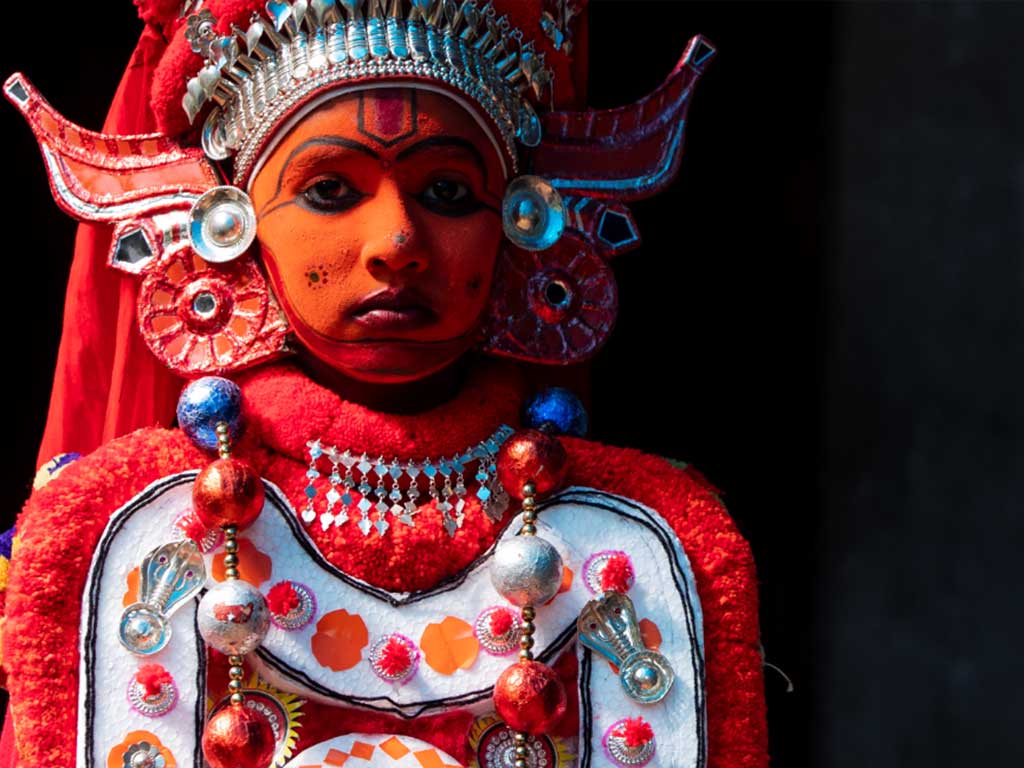Training
The Theyyam ritual dance is exclusively performed by the male members of the traditional caste groups like Vannan, Malayan, Velan, Mavilan, Pulayan and Koppalan. Though these artists belong to the lower castes of the society they were reverd by all regardless of caste during the time of the performance. For them performing Theyyam is a seasonal occupation and a social obligation. It is a seasonal occupation to these groups.
Like many other performing arts, there are different areas in Theyyam art which are to be specialised by an artist. An eminent artist generally achieves mastery over all these branches. They are recitation of Theyyam song or Thottam, make up, preparation of costumes, playing of instruments and dancing. There are about one hundred thottam songs pertaining to different gods and goddesses. Some of them are lengthy texts including the legends, myths and traditions of their respective folk deities. These songs are to be memorized by the artist. The methods of recitation and oral revelation like `Varavili` are to be mastered. The ragas or melody vary from one context to the other. Thus he must posses some knowledge of musicology. It takes 8 or 10 years to master every aspect of the performance. Normally the training starts when a boy is 7 or 8 years old. The teaching of Theyyam dance is given in a `gurukula model’. The eminent dancer teaches his sons, nephews or relatives and when they learn this they will also assist as make-up men or drummers. They appear in minor and unimportant items of deities in the village festivals. Morning hours are used for instruction. Oil massage is applied to the body of a young dancer. The artist has to undergo a good training in kalarippayattu especially if he is playing deities like Kathivannur Veeran, Poomaruthan and Pataveeran.
The tradition of Theyyam is inherited by a son from his father, or a nephew from his uncle. This practice has continued uninterruptedly for centuries.
In certain dance items the dancer has to wear burning wicks around his waist and has to observe fire walk wearing the heavy headdress.
Costumes The brilliant costumes used in Theyyam display the superb blend of artistic inspiration, concepts and ability. The magnetic designs and colour patterns render Theyyam its mystical touch. It is an astonishing fact that the raw materials for make-up were obtained from nature. Each deity has its style of dresses and ornaments. The make-up involves face painting in a different styles and body decoration. Different costumes like leaf dress or Tazha Adai, headdress or muti, `arayoda’ or Vattoda and other body decorations are to be prepared by the artists for performance.
Coconut spathes are used to make the costumes. Coconut spathes are cut and painted in black, white and red patterns to make the costumes. Fresh tender coconut fronds form skirts and coconut shells are used to make breasts. A red cloth is tied around the waist. The facial decorations are intricately designed with enriched symbolism. The hood, headdress, face painting, breastplate, bracelets, garlands and fabric of attire of each theyyam are distinct and meticulously crafted. Preparation of these items requires proper skill and craftsmanship and perfect knowledge of primary and secondary colour combinations


 Theyyam Performance
Theyyam Performance